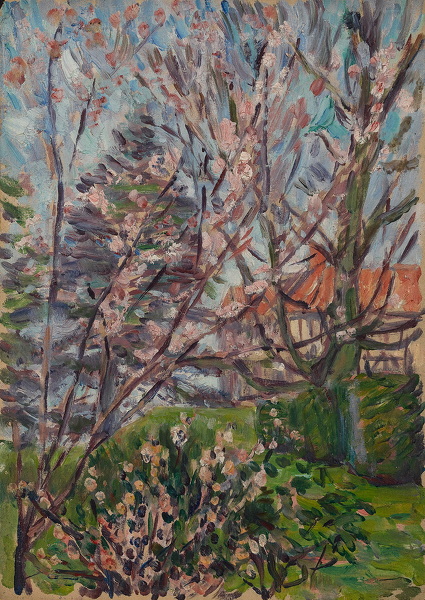

 Hover over the painting to magnify (there may be an initial delay while the magnified image is loaded)
Hover over the painting to magnify (there may be an initial delay while the magnified image is loaded)Arthur Studd (1863 - 1919):
Foreground view of branches with blossom, house to rear
Framed (ref: 2778)
Oil on panel, 8 3/4 x 6 1/4 in. (22.2 × 15.8 cm.)
See all works by Arthur Studd oil panel Highlights of 20/21 Art Fair landscape
Provenance: Peter Cochran;The Fine Art Society
Exhibited: (?) Arthur Studd, Alpine Club Gallery, London, June 1911
After meeting Whistler in Paris in 1892, Studd worked with him in 1894 and
1895 in London, where they were neighbours in Chelsea for some ears.The
style of this panel, which is related to three other views of Venice by Studd on similar sized panels (Tate), is indebted to Whistler’s paintings of beaches and seascapes. Studd was also a collector, and he bequeathed three major works by Whistler to the National Gallery, London (now in the Tate Collection): Symphony in White, No. 2:The Little White Girl; The Fire Wheel; and Nocturne: Blue and Silver – Cremorne Lights).
It’s commonly believed that Paul Gauguin worked in isolation in Tahiti, living in self-imposed exile from France and far from the reach of the European avant-garde. But from 1897 to 1898 Gauguin was joined in Tahiti by a British painter, Arthur Haythorne Studd (1863 – 1919). It was Studd’s wish, as he declared in a letter to his friend James McNeil Whistler (dated 22 June, 1897), to establish a ‘Studio of the South Seas’, and his work from Tahiti includes the View from Gauguin’s House, of 1898. This paper will compare Studd’s paintings to Gauguin’s treatment of the Tahitian subject, and examine how these artists imagined the Islands for a modern European audience. It will tease out the various influences on Studd’s Tahitian work, from his Slade School and Academie Julian training, to his ties to Whistler, and an artistic circle which included the New English Art Club, French painters Degas, Picard, and Puvis de Chavannes, and Australian Charles Conder. Notwithstanding the influence of contemporary artists, Studd’s paintings will also be understood in the context of colonial modernity and the extent to which modern political, economic and cultural agendas may have impacted his treatment of the Tahitian subject. Though the focus of this paper is on Studd’s contact with Gauguin and modernist re-imaginings of the Pacific Islands, it will also begin a biography of this important British painter and collector, whose story remains to be told. (2008 paper from the University of Queensland, S Australia)
Studd had one-man exhibitions during his lifetime at The Goupil Gallery (1896), The Baillie Gallery (1906) and The Alpine Club Gallery, London, (1911). He excelled in small plein air sketches, mostly oil on panel, such as this. Of the sixty paintings exhibited at The Alpine Club Gallery, London, in June 1911., at least twenty were views of Venice, eight under the generic title Venetian Lyric.
Exhibited: (?) Arthur Studd, Alpine Club Gallery, London, June 1911
After meeting Whistler in Paris in 1892, Studd worked with him in 1894 and
1895 in London, where they were neighbours in Chelsea for some ears.The
style of this panel, which is related to three other views of Venice by Studd on similar sized panels (Tate), is indebted to Whistler’s paintings of beaches and seascapes. Studd was also a collector, and he bequeathed three major works by Whistler to the National Gallery, London (now in the Tate Collection): Symphony in White, No. 2:The Little White Girl; The Fire Wheel; and Nocturne: Blue and Silver – Cremorne Lights).
It’s commonly believed that Paul Gauguin worked in isolation in Tahiti, living in self-imposed exile from France and far from the reach of the European avant-garde. But from 1897 to 1898 Gauguin was joined in Tahiti by a British painter, Arthur Haythorne Studd (1863 – 1919). It was Studd’s wish, as he declared in a letter to his friend James McNeil Whistler (dated 22 June, 1897), to establish a ‘Studio of the South Seas’, and his work from Tahiti includes the View from Gauguin’s House, of 1898. This paper will compare Studd’s paintings to Gauguin’s treatment of the Tahitian subject, and examine how these artists imagined the Islands for a modern European audience. It will tease out the various influences on Studd’s Tahitian work, from his Slade School and Academie Julian training, to his ties to Whistler, and an artistic circle which included the New English Art Club, French painters Degas, Picard, and Puvis de Chavannes, and Australian Charles Conder. Notwithstanding the influence of contemporary artists, Studd’s paintings will also be understood in the context of colonial modernity and the extent to which modern political, economic and cultural agendas may have impacted his treatment of the Tahitian subject. Though the focus of this paper is on Studd’s contact with Gauguin and modernist re-imaginings of the Pacific Islands, it will also begin a biography of this important British painter and collector, whose story remains to be told. (2008 paper from the University of Queensland, S Australia)
Studd had one-man exhibitions during his lifetime at The Goupil Gallery (1896), The Baillie Gallery (1906) and The Alpine Club Gallery, London, (1911). He excelled in small plein air sketches, mostly oil on panel, such as this. Of the sixty paintings exhibited at The Alpine Club Gallery, London, in June 1911., at least twenty were views of Venice, eight under the generic title Venetian Lyric.
 British Impressionists
British Impressionists SOLD
SOLD




